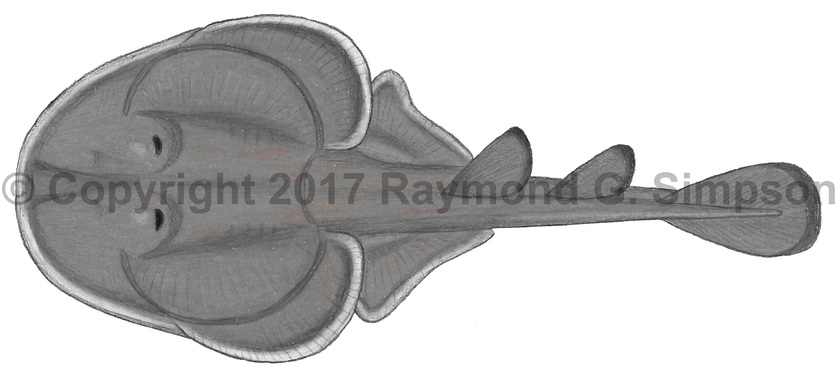
Common Name
Brazilian Blindray
Year Described
Rincón, Stehmann & Vooren, 2001
Identification
Disk small, thickened, and spoon-shaped with kidney-shaped electric organs under each pectoral fin base. Body quite flat along entire width. Mouth relatively small with well developed labial cartilage. Teeth tiny (9-13 rows) and visible when mouth is closed. Eyes not visible; buried in skin and visible only as faint spots anterior to spiracle. Spiracles large and round without papillae. Nostrils with broad nasal curtain. Pectoral fins very short and stumpy. Tail much longer than disk and lacks spines or ridges. Dorsal fins about equal in size. Inter-dorsal space about the length of dorsal base. Pelvic fins conspicuous as single large single lobes off the base of the tail. Pelvic fins not joined. Caudal fin rounded. Skin entirely smooth.
Color
Body unmarked medium to dark brown above with dark margins on the dorsal and caudal fins. Belly pure white with dusky margins.
Size
A very small electric ray: maximum size to 27cm TL and maturing at over 10cm smaller.
Habitat
A deepwater species found on continental slopes (450-530m).
Range
So far known only from southern Brazil.
References
Last, P.R., White, W.T., Carvalho, M.R. de, Séret, B., Stehmann, M.F.W & Naylor, G.J.P (Eds.). 2016. Rays of the World. CSIRO Publishing, Melbourne.
Rincon, G., M.F.W. Stehmann, & C.M. Vooren. 2001. Results of the research cruises of FRV ‘Walther Herwig’ to South America. LXXIV. Benthobatis kreffti n. sp. (Chondrichthyes, Torpediniformes, Narcinidae), a new deep-water electric ray from off South Brazil and the third species of the genus. Archive of Fishery and Marine Research, 45-60.
Other Notes
This species is much smaller, more oval-shaped, has fewer tooth rows, and has a lower upper caudal lobe than Benthobatis marcida.